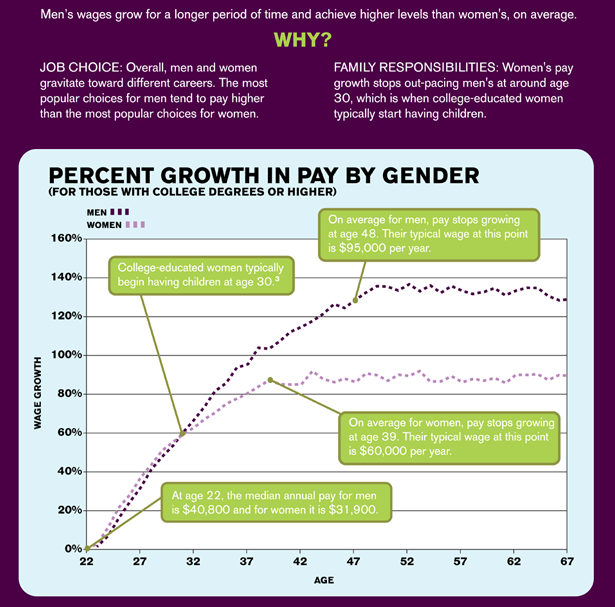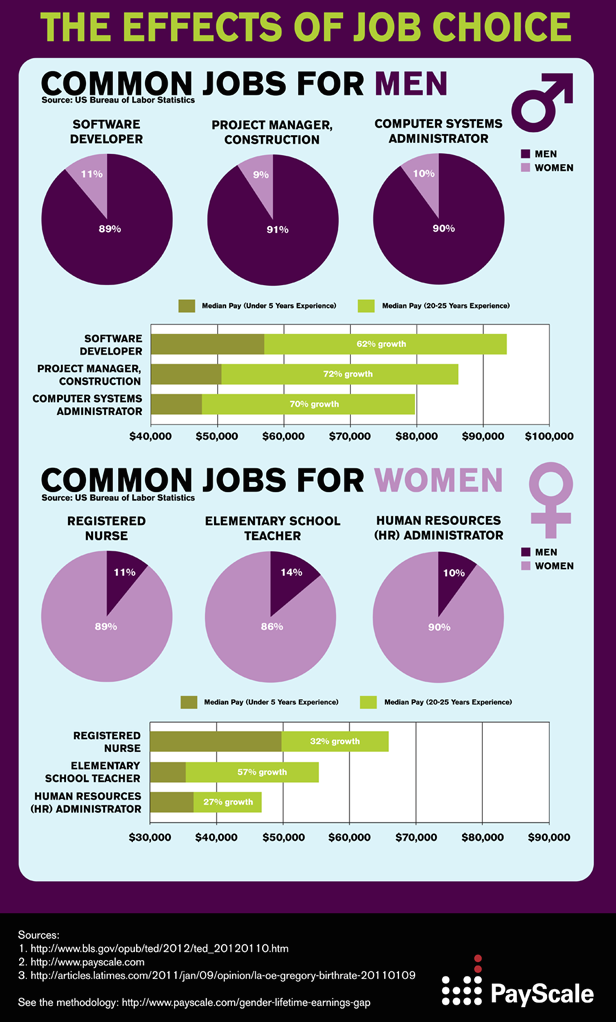Bad Chart Thursday: Redditors Prove the Gender Wage Gap is a Myth

Ladies, you can all stop complaining about not being paid as much as men because Reddit has determined that there is no gender wage gap. Reddit user Rhiever posted in r/dataisbeautiful an article that proves the gender wage gap doesn’t exist, writing “When you compare salaries for men and women who are similarly qualified and working the same job, no major gender wage gap exists.”
Clicking the link in his Reddit post probably goes to some super scientific study, right? I mean, rhiever seems so sure of himself that he must have some very good data to back up his claims. In fact, clicking the link takes you to an infographic by for-profit wage comparison company PayScale.com. That’s right, the same PayScale that wrote a terrible fake “study” two years ago that I mocked right here on Skepchick twice. Perhaps they learned from my takedown of their previous study and actually used a scientific methodology this time around.
According to this first part of the PayScale infographic, if you compare men and women that are similarly qualified and in the exact same jobs, the pay gap is smaller than the 80 cents on a dollar that the evil feminists claim. Of course, no one is claiming that the “80 cents per dollar” number comes from comparing women and men of the same qualifications and job titles. It’s supposed to show the structural sexism that exists in society that puts women at a disadvantage in hiring, promotions and salary, not to mention discourages them from even entering high-paid fields. Even if women were getting paid equal to men in the same exact jobs, women are still at a disadvantage if they have a harder time getting those jobs or aren’t able to get promoted as often as their male counterparts. Plus, the PayScale chart still shows men making more than women in the six positions they chose to feature to prove that men make the same amount as women. I’m honestly confused as to how this chart is supposed to prove that men and women in the same jobs make the same amount of money when they apparently couldn’t come up with one job title where men and women are paid the same.
I also have to question why they chose these six positions out of all the possible jobs in the world. Were these the positions with the most people in them so the data is closest to accurate? Were they chosen randomly? Did these positions best represent the full job dataset? Or, did PayScale specifically choose these six positions because they had the smallest wage gap and proved their point better than all the other jobs?
Oh good, PayScale is going to give us reasons why the wage gap doesn’t really exist. The first explanation they provide is job choice. Women just choose jobs that pay less because women don’t like money or something. Right? Or, err… there has to be a better reason than that. I wonder why women would possibly not want jobs that make more money, unless there is something discouraging them from the higher-paid jobs. You know, possibly something “structural” that disadvantages women.
The second reason PayScale gives for women making less money than men is that college-educated women have children at age 30. Of course, only 30% of people in the United States actually get a bachelor’s degree or higher. I’m not sure what the other 70% of women’s excuse is. Also, having children only effects women because men don’t have children, leaving them free to take all the money from the money-hating mothers.
Can we just take a second to admire that wonderful chart? There are so many glorious things happening on that chart that it’s hard to know where to begin. Let’s start with the y-axis. When I first saw this chart, I thought the y-axis was median or average income, but in fact it’s labeled as “wage growth.” Then I got even more confused because wages seem to be growing exponentially, meaning WE ARE ALL RICH! 32 year old women have 60% wage growth! I’m 32 next year so I assume I can look forward to a 60% raise. Someone tell my employer!
But alas, the y-Axis is clearly not showing yearly growth. Instead, it’s showing growth over the median pay by gender at age 22. In other words, it’s essentially just showing income on the y-axis labeled in a different fashion. Of course, if they actually showed income rather than “growth” their male and female lines between ages 22 to 32 would no longer be on top of each other because the women are starting out with a baseline $8900 lower than the average man. That’s right. At age 22 women make only 78 cents for ever $1 earned by a man according to the chart. In order to hide this on their chart, PayScale normalizes each gender by their baseline at age 22 then shows their higher income in the future as the percent gained from that baseline. Since they show the growth in percent of the baseline, it also means that women’s income in real dollars is growing less than for men. At age 30 it shows that both men and women have had a wage growth of 60%. That means that men’s income rose from $40,800 at age 22 to $65,280 at age 30 and women’s income rose from $31,900 at age 22 to $51,040. The gender wage gap also increased during these eight years from $8900 at age 22 to $14,240 at age 30. At age 30 women are still only making 78 cents for every man’s dollar.
After age 30, according to the PayScale chart, women’s income growth slows while men’s continues to rise. According to PayScale all the ladies started having babies the second they reached 30, explaining the entire gap. Women’s income tops out at age 39 at $60,000 per year. Men’s income continues to rise until they hit $95,000 per year at age 48. Wait a second… the median man is making $95k in income by age 39?? Really? Somehow I’m not quite sure I really trust this data.
Even if we assume their underlying data is correct, they are claiming that at age 48 men are making $95k per year while women are stuck at $60k per year. That’s now 63 cents that a women makes per every dollar that goes to a man. I’m starting to wonder if we can really chalk this up to all women having children at age 30. More likely, women are able to do well and get promoted in their careers up to a certain point, but the higher they get the less likely they are to be promoted, which causes their income growth to stagnate. Companies tend to have less and less women the higher you get in the company, which would lead to men continuing to see wage growth while women’s income stays steady in the second half of their career.
This part of the chart is just showing that men have higher paid jobs than women. They call it “job choice,” because again, women “choose” lower paid jobs. The fact that jobs in software development, construction, and computer systems may have atmospheres toxic to women isn’t the fault of the job. If women really wanted all the money they would just “choose” it. It’s that simple. My absolute favorite part of this last infographic section though is the “Sources” if only because they list “payscale.com” as a “source.”
Now, I’ve been really hard of PayScale for this infographic, but unlike most infographics they included a methodology! I’m sure their methodology will answer all the confusion and questions I had when reading their infographic. This section probably explains how they determined that jobs and experience were similar in order to control for those aspects when comparing men and women with the same jobs and qualifications. PayScale wrote the following:
To compare male and female pay on a level playing field, we found the median pay for all men in a given job, as well as breakdowns of important compensable factors such as years of experience, location, education level, etc. Then, using PayScale’s proprietary MarketMatch™ Algorithm, we determined what the female median pay would be using the exact same blend of compensable factors as our control male group.
Wait…that’s it? The way PayScale controlled for job type and experience was [REDACTED]. Sorry PayScale, but you can’t call this section “methodology” and then just announce PROPRIETARY ALGORITHM and leave it at that. You can’t show us your actual methodology because it’s SOOPER SECRET, but we should just trust you that it’s good?
I’m calling bullshit on this entire exercise. PayScale, just stop. Stop coming out with “WE PROVED THE GENDER WAGE GAP DOESN’T EXIST” articles every single damn year. And Reddit, stop using terrible infographics from for-profit websites with questionable data as proof that feminists are evil lying liars.








And of course, in some fields, the culture is outright hostile to women. You can tell because people in those fields use their free time to produce infographics about the pay gap that fail to take into account that in some fields, the culture is outright hostile to women.
Data IS beautiful.
Shitty data chosen to push a narrative at the expense of honesty is beautiful in how it reflects the shitty biases of the narrative pusher.
I like how they’re all “women have children at 30” like there’s no men involved in that equation. I guess we cis-women just fertilize ourselves…
As a dude in Software Engineering, I can state with authority that if you’re comparing men’s incomes to women’s in this profession, you’re off your goddamn rocker. There are so few women in this field as to be non-existent. So EVEN IF their salaries here are comparable, it just does not matter–they are clearly not being offered the smooth path to employment here that men are.
And that being said: study, after study, after study, after study, after study shows that women in comparable fields are paid less than men. This is not even open to debate anymore. Debate the reasons all you want, but the effects are documented.
As a white man in a white male-dominated field, I *want* more women and minorities to take part and be employed in this field. There are manifold reasons for that, which I cannot even hope to address here. But a few:
– Diversity leads to a better product. It’s a running joke that Microsoft’s voice recognition software initially could only translate white men between the ages of 20 and 35 because guess who wrote/tested the product?
– Diversity leads to a BETTER PRODUCT. If your artistic concept only involves white men, guess who is going to be interested in it? More sales = MORE SALES. Appeal to a wider audience! Women constitute the bulk of the population.
– Diversity leads to better understanding. I think this stands on its own, so I will not expand upon it. Seriously, if you dispute this, you need help.
And last, but surely not least: for fuck’s sake, don’t be an asshole. Give women and minorities the same chances that we white men have. And I don’t mean just legally, I mean culturally. Anyone complaining about how “Saudi Arabia is not utilizing half its population” needs to wake the fuck up and realize that neither is the USA. And that person also needs to stop saying “utilize” instead of “use”, but that’s a separate issue.
Aren’t they saying that they looked at men’s salaries, calculated the median, and then made up a number for the women?
Yup. It sounds like they got the men’s pay then they took the women’s pay and “adjusted” it to match the experience of the men using a mysterious algorithm that they won’t show anyone.
They did some similar “controlling” of women’s salaries on the “study” they put out two years ago, but again they didn’t release anything on how exactly they adjusted women’s salaries: http://skepchick.org/2013/06/for-profit-wage-comparison-website-overturns-feminist-dogma-or-not/
My guess, based on the way they wrote about it, was that they put people into years-of-experience and degree buckets, then re-weighted those buckets to match the distribution of the men in the sample. However, that hardly seems like something that would be considered a proprietary algorithm, so they’re probably adding some secret-sauce calculation to the mix, which could be doing who-knows-what.
Huh. I’m surprised they didn’t go ahead and put women’s wages out in front, then. I mean, if you’re just making it up, what difference does it make?
Here’s my theory: They assumed all the men were getting paid in dollars, but all the women were getting paid in an invented currency called “femodollars”. They then went back and historically adjusted the femodollars to real dollars exchange rate (based on the equal real value of work), then integrated over the varying exchange rates to get total wages, and finally converted femodollars to real dollars at the current exchange rate. This is why the pay came out so close. It algorithmically had to.
Was very happy when I came across this piece (this, the Skepchick one, not the reddit one).
I saw those charts a few days ago and thought the same thing. Total BS.
They take some [bad] analysis showing that the pay gap may be somewhat smaller than 80%. And they dress it up with a headline and some carefully selected charts that communicate that the pay gap does not exist.
As a man, I was offended by this.
As a man, I found this article offensive.
And where did they get any of their numbers from? My husband is 54. He got a 10% raise last week. What’s with this income growth stopping by 48? He is not making nearly $95,000 per year. We are not poor! No, we’re not rich, but we’re definitely above average!
I stopped working at 40, but that was due to disability. I did not have any children by 30! My first son was at 35.
I can’t trust any of their numbers when the ones I can check our wrong!
One reason for the pay stagnation that hits women as they advance up the ladder was discovered by a study of British companies. They compared executive pay between two categories of companies–those who took a confidential approach to compensation, and those who made their compensation transparent.
Companies where executives could essentially cross-check their pay against their peers showed a markedly smaller pay-gap. It’s worth noting that as you move up the ladder, compensation is often a negotiated thing, rather than set by policy. So in confidential companies, you have to negotiate blind, with no idea what the company considers ‘reasonable’–and hey, guess what? Our culture socializes women to not be aggressive in negotiations, AND encourages employers (and car dealerships, and home sellers) to make women inferior offers.
In a transparent company, however, Jill, applying for the SVP-Marketing position knows that John, the SVP-HR, is making $225K with a performance bonus on top, and so knows that she should be seeking something comparable.
I was agreeing up to this part…. “I wonder why women would possibly not want jobs that make more money, unless there is something discouraging them from the higher-paid jobs. You know, possibly something “structural” that disadvantages women.”.